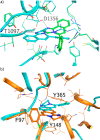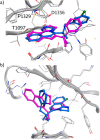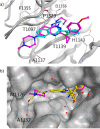Discovery of New Binders for DCAF1, an Emerging Ligase Target in the Targeted Protein Degradation Field
- PMID: 37465299
- PMCID: PMC10350940
- DOI: 10.1021/acsmedchemlett.3c00104
Discovery of New Binders for DCAF1, an Emerging Ligase Target in the Targeted Protein Degradation Field
Abstract
In this study, we describe the rapid identification of potent binders for the WD40 repeat domain (WDR) of DCAF1. This was achieved by two rounds of iterative focused screening of a small set of compounds selected on the basis of internal WDR domain knowledge followed by hit expansion. Subsequent structure-based design led to nanomolar potency binders with a clear exit vector enabling DCAF1-based bifunctional degrader exploration.
© 2023 American Chemical Society.
Conflict of interest statement
The authors declare no competing financial interest.
Figures










Similar articles
-
Discovery of a Novel DCAF1 Ligand Using a Drug-Target Interaction Prediction Model: Generalizing Machine Learning to New Drug Targets.J Chem Inf Model. 2023 Jul 10;63(13):4070-4078. doi: 10.1021/acs.jcim.3c00082. Epub 2023 Jun 23. J Chem Inf Model. 2023. PMID: 37350740 Free PMC article.
-
Discovery of Nanomolar DCAF1 Small Molecule Ligands.J Med Chem. 2023 Apr 13;66(7):5041-5060. doi: 10.1021/acs.jmedchem.2c02132. Epub 2023 Mar 22. J Med Chem. 2023. PMID: 36948210 Free PMC article.
-
Inhibition of Vpx-Mediated SAMHD1 and Vpr-Mediated Host Helicase Transcription Factor Degradation by Selective Disruption of Viral CRL4 (DCAF1) E3 Ubiquitin Ligase Assembly.J Virol. 2017 Apr 13;91(9):e00225-17. doi: 10.1128/JVI.00225-17. Print 2017 May 1. J Virol. 2017. PMID: 28202763 Free PMC article.
-
WD40 repeat domain proteins: a novel target class?Nat Rev Drug Discov. 2017 Nov;16(11):773-786. doi: 10.1038/nrd.2017.179. Epub 2017 Oct 13. Nat Rev Drug Discov. 2017. PMID: 29026209 Free PMC article. Review.
-
Recent Progress in Modulation of WD40-Repeat Domain 5 Protein (WDR5): Inhibitors and Degraders.Cancers (Basel). 2023 Aug 1;15(15):3910. doi: 10.3390/cancers15153910. Cancers (Basel). 2023. PMID: 37568727 Free PMC article. Review.
Cited by
-
Identification and Development of BRD9 Chemical Probes.Pharmaceuticals (Basel). 2024 Mar 19;17(3):392. doi: 10.3390/ph17030392. Pharmaceuticals (Basel). 2024. PMID: 38543178 Free PMC article. Review.
-
Discovery of DCAF16 Binders for Targeted Protein Degradation.ACS Chem Biol. 2025 Feb 21;20(2):479-488. doi: 10.1021/acschembio.4c00799. Epub 2025 Jan 30. ACS Chem Biol. 2025. PMID: 39882752
-
DCAF1-based PROTACs with activity against clinically validated targets overcoming intrinsic- and acquired-degrader resistance.Nat Commun. 2024 Jan 4;15(1):275. doi: 10.1038/s41467-023-44237-4. Nat Commun. 2024. PMID: 38177131 Free PMC article.
-
Targeted Protein Degradation through Recruitment of the CUL4 Complex Adaptor Protein DDB1.ACS Chem Biol. 2024 Jan 19;19(1):58-68. doi: 10.1021/acschembio.3c00487. Epub 2024 Jan 8. ACS Chem Biol. 2024. PMID: 38192078 Free PMC article.
-
Implications of frequent hitter E3 ligases in targeted protein degradation screens.Nat Chem Biol. 2025 Apr;21(4):474-481. doi: 10.1038/s41589-024-01821-z. Epub 2025 Jan 27. Nat Chem Biol. 2025. PMID: 39870762 Review.
References
-
- Xu C.; Bian C.; Yang W.; Galka M.; Ouyang H.; Chen C.; Qiu W.; Liu H.; Jones A. E.; MacKenzie F.; Pan P.; Li S. S.-C.; Wang H.; Min J. Binding of different histone marks differentially regulates the activity and specificity of polycomb repressive complex 2 (PRC2). Proc. Natl. Acad. Sci. U. S. A. 2010, 107, 19266–19271. 10.1073/pnas.1008937107. - DOI - PMC - PubMed
-
- Tao Y.; Remillard D.; Vinogradova E. V.; Yokoyama M.; Banchenko S.; Schwefel D.; Melillo B.; Schreiber S. L.; Zhang X.; Cravatt B. F. Targeted Protein Degradation by Electrophilic PROTACs that Stereoselectively and Site-Specifically Engage DCAF1. J. Am. Chem. Soc. 2022, 144, 18688–18699. 10.1021/jacs.2c08964. - DOI - PMC - PubMed
-
- Huang Y.; Zhang J.; Yu Z.; Zhang H.; Wang Y.; Lingel A.; Qi W.; Gu J.; Zhao K.; Shultz M. D.; Wang L.; Fu X.; Sun Y.; Zhang Q.; Jiang X.; Zhang J.; Zhang C.; Li L.; Zeng J.; Feng L.; Zhang C.; Liu Y.; Zhang M.; Zhang L.; Zhao M.; Gao Z.; Liu X.; Fang D.; Guo H.; Mi Y.; Gabriel T.; Dillon M. P.; Atadja P.; Oyang C. Discovery of First-in-Class, Potent, and Orally Bioavailable Embryonic Ectoderm Development (EED) Inhibitor with Robust Anticancer Efficacy. J. Med. Chem. 2017, 60, 2215–2226. 10.1021/acs.jmedchem.6b01576. - DOI - PubMed
LinkOut - more resources
Full Text Sources
Other Literature Sources
Chemical Information
Molecular Biology Databases

